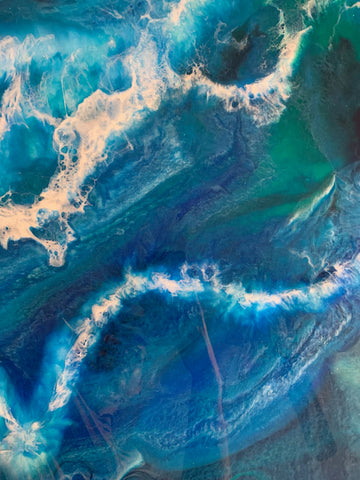What is the Difference Between Resin Art and Acrylic Pouring/Fluid Art?
There are a variety of fluid art forms, most of which you've probably seen doing the rounds on Instagram, Facebook and even TikTok. It can sometimes be confusing distinguishing between them as visually, they do share a lot of similarities but they also have some key differences when it comes to application, finish and degree of difficulty.
Let's dive in to three of the most popular kinds - resin art, fluid acrylics and alcohol ink art.
Resin art is created by mixing pigment, dyes or additives like glitter into an epoxy resin. Epoxy resin is often categorised as a glue or adhesive and is a 2-part system, that when mixed together, causes a chemical reaction, resulting in the clear substance to cure and harden within 30-50 minutes. Epoxy resin cures to a solid, shiny, glass like finish which makes it great for quick, easy and super impactful designs. Epoxy resin is also quite commonly used as a finishing clear layer over other fluid art forms, such as acrylic pouring as it creates a durable, high-shine glossy finish and makes colours and details pop. For best effects, you should colour your epoxy resin with epoxy pigments or pigment powder.
Because Epoxy resin takes some time to cure and has a non-flexible finish, it is best used on non-pourous, rigid surfaces such as wooden art boards, serving boards, cheeseboards, mirrors, tabletops and plastic. It's not ideal for stretched fabric canvas - this is better left for fluid acrylics.

Fluid acrylic paintings are made by mixing acrylic paint with an acrylic-based thinning additive; this additive basically makes your acrylic paint runnier without changing its drying abilities. Fluid acrylic painting is similar to resin art in a number of ways - the pouring techniques are often the same, the marbelling textures look alike, they can be done on large or small scale canvases and they are both a lot of fun! However the key difference is fluid acrylics do not dry down to a high-shine, durable finish like resin does, and fluid acrylic paintings often dry down more dull than they were when they were freshly poured. You can also create acrylic paintings on stretched canvas without worrying that the finished artwork will warp or crack. If you want to have a high-shine finish on your acrylic art, make sure you create it on a wooden artboard and then seal with a layer of clear resin to protect your art and make it shine!

Alcohol ink art is probably the most distinct out of the three fluid artforms and is made by dropping and mixing alcohol ink dyes with isopropyl alcohol on non-pourous surfaces such as synthetic paper (Yupo and Nara papers are popular), glass, ceramic, mirror, aluminium composite board and tile. You can create a variety of effects with alcohol inks and they are fun and cost effective to start out with. Alcohol ink can also be used to colour resin or dropped on top of wet resin to create water-marble-like effects as the alcohol reacts with the resin. Alcohol ink paintings can also be adhered to an artboard and covered with a layer of clear resin for a hardy, high-shine finish.

All of these fluid art forms are so much fun, however we do think resin art reigns supreme (we may be biased!) because you can mix it, colour it, pour it and leave it to cure for 12 hours and when you return it is a shiny, glossy, super professional looking artwork ready to display!
So stop dreaming about the art you could create and do the damn thing! Grab a kit today and start experimenting!

I was wondering if brushes, sponges can be reused with resin somehow? With paint thinner or alcohol? Can resin be scraped off glass, mirrors cleanly after it dries if one changes one’s mind or wants to redo sections? If resin has dried, can you paint over the layer without disturbing it? I’m interested in 3D effects. When viewed from the side, a glass cup has 4 surfaces…